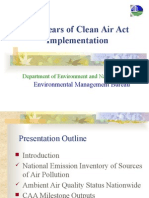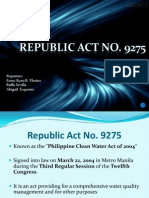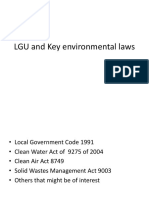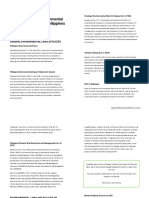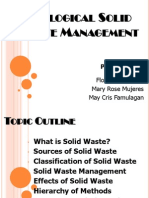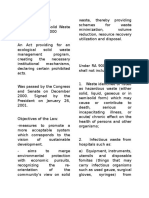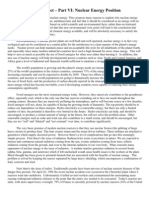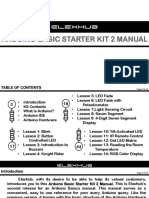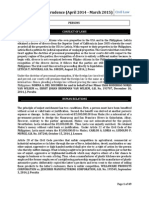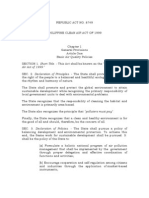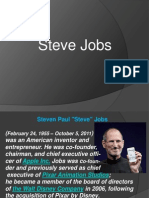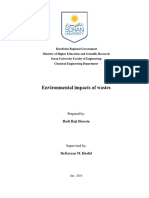Republic Act 8749: The Philippine Clean Air Act of 1999
Republic Act 8749: The Philippine Clean Air Act of 1999
Uploaded by
Tabs NetCopyright:
Available Formats
Republic Act 8749: The Philippine Clean Air Act of 1999
Republic Act 8749: The Philippine Clean Air Act of 1999
Uploaded by
Tabs NetOriginal Title
Copyright
Available Formats
Share this document
Did you find this document useful?
Is this content inappropriate?
Copyright:
Available Formats
Republic Act 8749: The Philippine Clean Air Act of 1999
Republic Act 8749: The Philippine Clean Air Act of 1999
Uploaded by
Tabs NetCopyright:
Available Formats
REPUBLIC ACT 8749
The Philippine Clean Air Act of 1999
THE PRESENT ATMOSPHERE
COMPOSITION OF PRESENT ATMOSPHERE
78% Nitrogen 21% Oxygen (O2) 0.9% Argon 0.03% Carbon Dioxide and trace amounts of other gases Air Pressure: - Sea Level: 14.7 PSI - Altitude of 10T Feet: 10 PSI
HISTORICAL ATMOSPHERE
Earth believed to have formed 5B year ago In the initial 500M years, dense atmosphere emerged from vapor and gases due to degassing of the planets interior Prior to 3.5B years ago, atmosphere consisted of CO2, CO, H2O, N2 and Hydrogen Hydrosphere formed 4B years ago from condensation of water vapor resulting to oceans of water Absence of Free Oxygen
FORMATION OF OZONE LAYER
1B years ago, early aquatic organisms (blue algae) began using sun energy to split molecule of H2O and CO2 and recombine them into organic compounds and molecular oxygen (O2) process known as photosynthesis High in the atmosphere, some O2 molecules absorbed energy from suns ultraviolet rays and split to from single oxygen atoms (O)
O atoms combined with remaining O2 to form O3 molecules (OZONE) O3 are very effective at absorbing UV rays Thin layer of ozone acts as a shield protecting Earth from irradiation by UV light Amount of ozone required to shield Earth from biologically lethal UV radiation: 200-300 nanometer
The ozone layer existed 600 M years ago Oxygen level at this time: only 10% Prior to this period life on Earth restricted to Oceans The presence of ozone enabled organisms to develop and live on dry land OZONE PLAYED KEY ROLE IN EVOLUTION OF LIFE ON EARTH!
AIR QUALITY PRINCIPLES
State to protect and advance the right of the people to a balanced and healthful ecology in accord with the rhythm and harmony of nature (Sec. 16, Art. II, Phil. Constitution) Sustainable Development Area-based Responsibility Polluters-Must-Pay GOOD FOR ALL-CONCERN FOR ALL.
AIR QUALITY POLICIES
Holistic (Comprehensive) National Program Self-Regulation Pollution Prevention not Control Public Education and Participation System of Accountability & Setting up of Air Quality Management Fund
DEMANDABLE RIGHTS
To breathe clean air To utilize and enjoy natural resources in accord with sustainable development principle To participate in the formulation of environmental policies To participate in decision-making To be informed on the nature and extent of potential hazard and to be served of TIMELY notice
To access public records (See Sec. 8, Art. III, 1987 Phil. Constitution) To enjoin activities that violate environmental laws and regulations To compel rehab and clean up To seek imposition of penalties against violators To seek compensation by way of personal damages
WHAT IS AN AIR POLLUTANT?
Any matter found in the atmosphere other than; - Oxygen - Nitrogen - Water Vapor - Carbon Dioxide; and - Inert Gases IN THEIR NATURAL AND NORMAL CONCENTRATIONS
- Detrimental to health or Environment - Includes (but not limited to): SMOKE DUST SOOT CINDER FLY ASH SOLID PARTICLES (ANY KIND) GASES FUMES CHEMICAL MISTS CONTAMINATED STEAM RADIOACTIVE SUBSTANCES
WHAT IS AIR POLLUTION?
1) Any alteration of the -physical -chemical -biological properties of the atmospheric air; or 2) Any discharge into the atmosphere of any liquid, gaseous, or solid substances that: - will or likely create or render the air resources harmful, detrimental, or injurious to public health, safety or welfare; or - will adversely affect their utilization
AMBIENT AIR QUALITY STANDARD
The concentration of an air pollutant which, in order to protect public health and/or public welfare, shall not be exceeded in the breathing zone, at any time. This is enforceable upon the owner or person incharge of an industrial operation, process or trade.
GREENHOUSE GASES
Those gases that can potentially or can reasonably be expected to induce global warming, including: - carbon dioxide - oxides of nitrogen - chloroflourcarbons - and the like
HAZARDOUS SUBSTANCES
Those that present: 1) short-term acute hazards, e.g. acute toxicity by ingestion, inhalation or skin absorption, corrosivity or other skin or eye contact or the risk of fire explosion; or 2) long-term toxicity thru: - repeated exposure - carcinogecity - resistance to detoxification process, e.g. biodegration - the potential to pollute underground or surface water
KINDS OF WASTES THAT MAY AFFECT AIR QUALITY
INFECTIOUS WASTES PATHOLOGICAL WASTES PHARMACEUTICAL WASTES CHEMICAL WASTES MEDICAL WASTES MUNICIPAL WASTES
MEDICAL WASTES
Materials generated as a result of patient diagnosis, treatment, or immunization of human beings or animals.
MUNICIPAL WASTES
The waste materials generated from communities within a specific locality
OCTANE REQUIREMENT OF VEHICLES
OCTANE RATING OR ANTI-KNOCK INDEX = Research Octane Number (RON) + Motor Octane Number 2
- The octane requirement of automobiles shall refer to the minimum octane rating the manufacturer sets for efficient operation for the vehicle without knocking
OZONE DEPLETING SUBSTANCES (ODS)
Those that deplete or modify significantly the ozone layer resulting to adverse effects of humans and the environment, e.g. chloroflourocarbons, halons, etc.
PERSISTENT ORGANIC POLLUTANTS
The organic compounds that: - Persist in the environment - Bioaccumulate through the food web; and -Pose a risk of causing adverse effects to human health and the environment Characteristics: Resist photolytic, chemical and biological degradation. Examples: Dioxin, Furan, Polychlorinated Biphenyls (PCBs), Organochloride Pesticides (e.g. aldrin, dieldrin, DDT, hexachlorobenzene, lindane, etc.)
POISONOUS AND TOXIC FUMES
Emissions and fumes beyond internationally-accepted standards
AIRSHED
Refers to areas with common weather or meteorological conditions and sources of air pollution which affect the interchange and diffusion of pollution in the surrounding atmosphere.
INCINERATION
Means the burning of municipal, bio-medical and hazardous wastes which process emits toxic and poisonous fumes (?) Case: MMDA V. JANCOM, G.R. 147465, Jan. 30, 2002 Ruling: Sec. 20 does not absolutely prohibit incineration as a mode of waste disposal; rather only those burning processes which emit poisonous and toxic fumes are banned.
BAN ON INCINERATION
Only those processes that emit poisonous and toxic fumes Exceptions (Even if emitting poisonous and toxic fumes): - Traditional small-scale method of community/neighborhood sanitation siga - Traditional agricultural, cultural, health and food preparation - Crematoria
NORMAL CUBIC METER (NCM)
Means the volume of dry gas which occupies a cubic meter measured at 25C at an absolute pressure equivalent to 760 mm Hg.
NATIONAL MOTOR VEHICLE INSPECTION PROGRAM
Activities/efforts designed to reduce the damaging impact of air pollution and unsafe vehicles on health and safety of the people, thru adoption of standards for emission and vehicle safety, and series of measures to ensure compliance.
National Ambient Air Quality Guideline Values (Short Term)
Suspended Particulate Matter (TSP - 230 mg/NCM; PM 150 mg/NCM at 24-hr averaging time) Sulfur Dioxide (180 mg/NCM; 0.07 PPM at 24-hr averaging time) Nitrogen Dioxide (150 mg/NCM); 0.08 PPM) Photochemical Oxidants as Ozone (140 mg/NCM; 0.08 PPM at 1 hr. average time or 60 mg/NCM; 0.03 at 8-hr. average time) Carbon Monoxide (35 mg/NCM; 30PPM at 1 hr. averaging time or 10 mg/NCM; 9 PPP at 8-hr. averaging time) Lead (1.5 mg/NCM at 3-month averaging time)
ATTAINMENT AREAS
Areas where existing ambient air quality is at or below NAAQGV. Requirement in Attainment Areas: Existing sources must comply with National Emission Standards for Source Specific Air Pollution and Ambient Air Quality Standards (Sec. 1 Rule IX, IRR). To submit Compliance Plan within 2 mos. from notice of non-compliance.
NON-ATTAINMENT AREAS
Those where existing ambient air quality is NOT IN CONFORMANCE with NAAQGV (Sec. 1, Rule XI, IRR). Special consideration given to densely populated areas where greater number of people may be exposed to unhealthy air. Relative designation.
EMISSION CHARGE SYSTEM
Application of Polluters-must-pay principle Regular emission fees imposed on dischargers Based on the volume and toxicity of any emitted pollutant Tax incentives to industries installing pollution control devices or retrofit
AIR QUALITY MANAGEMENT FUND
Sources: Air Emission Charges, Fines and Penalties, Grants, % from Program Loan for MM Air Quality Improvement Sector Development Program. Uses: Purchase of Equipment re Air Quality Monitoring, Reporting or Management; Public Awareness Campaigns; Research; Remunerations.
PERMITS REQUIRED (Rule XIX, IRR)
Coverage: All Sources Authority to Construct Permit to Operate Assignment of Valid Permit Renewal Others
AUTHORITY TO CONSTRUCT (Sec. 3, Rule XIX, IRR)
Covered: All proposed construction/modification of sources with potential to emit 100 tons/year or more of any of the regulated pollutants Engineering Report on plant description & operations Plans & Specs of installation and control facilities Air Quality Impact Analysis Vicinity Map
PERMIT TO OPERATE (Sections 4 & 5, Rule XIX, IRR)
Conversion of ATC to Permit to Operate within 60 days from startup General Rule: 1 Permit per source Exception: Facilities with more than one source may group the sources under one Permit provided the requisites under Sec. 5 are met
GROUNDS FOR SUSPENSION /REVOCATION OF PERMIT
Violation of any provision of the Act False or inaccurate information leading to issuance or in the required monitoring data/reports Refusal to allow inspection Non-payment of fees Other valid grounds
FINANCIAL LIABILITY FOR REHABILITATION (RULE XX)
Proponent to put up Financial Guarantee Mechanisms to finance emergency response, clean-up, rehab. Continuing Liability even after project termination. In the form of Trust Fund, Environmental Insurance, Surety Bonds, Letters of Credits, Self- Insurance.
EMISSION AVERAGING (Rule XXI)
Facilities with multiple sources may avail of emission averaging for compliance purposes Requisites: - Facilities are within a contiguous property - Owned by the same entity - Enforceable Compliance Plan - Installation of Continuous Emission Monitoring System (CEMS)
EMISSION TRADING (Rule XXII)
Emission Trading allowed among Pollution Sources for compliance purposes whether within or different airsheds Requisites: - Enforceable Compliance Plan - Installation of approved CEMS at source used to generate emission reduction credits
TAX INCENTIVES (Rule XXII)
Covered: Industries with Pollution Control Devices or with Retrofit Mechanisms that reduce pollution Nature: - Tax Credits - Accelerated depreciation deductions
RIGHT TO ENTER PREMISES (Sec. 2, Rule XXIV)
Right to enter any premises or to access documents and materials required from any person who owns or operates any emission source Right to inspect any pollution or waste source, control device, monitoring equipment or method required Right to test emission
PUBLIC CHARACTER OF THE RECORDS
All documents relating to relevant reports and records as required in Sec. 1 Rule XXIV are to be available to the public for inspection (Sec. 3, Rule XXIV).
POLLUTION FROM STATIONARY SOURCES
National Emission Standards for Source Specific Air Pollutants (NESSAP) applicable in general to any trade, industry process, fuel-burning equipment or industrial plant emitting air pollutant to be measured at the point of emission (See Table 2, Sec. 1 Rule XXV).
POLLUTION FROM FACTORIES
Table 2. NATIONAL EMISSION STANDARDS FOR SPECIFIC AIR POLLUTANTS (NESSAP)
Antimony & its cmpds. 10 as Sb (Any source) Arsenic & its cmpds. 10 as As (Any source) Cadmium & its cmpds. 10 as Cd (Any source) Carbon Monoxide 500 as Co (Any industrial source) Copper & its cmpds. 100 as Cu ( Any industrial source Hydrofluoric Acid and Fluoride Cmpds 50 as HF (Any source except Aluminum manufacturer
Hydrogen Sulfide a) Geothermal Power Plants not more than 150 g/GMW-Hr for new; 200 g/GMW-hr for existing b) Geothermal Exploration and Well Testing Best Available Control Technology a) Any other source -7 as H2S Lead 10 as Pb (Any trade, industry, process)
Mercury 5 as elemental Hg (Any source) Nickel & its cmpds. except Nickel Carbonyl 20 as Ni (Any source) NOx a) Manufacturer of Nitric Acid 2,000 as acid & NO2 b) Fuel Burning Steam Generators 1,500 as NO2 b.1) Existing 1,000 as NO2 b.2) New Source Coal-fired 500 as NO2 Oil-fired 500 as NO2 c) Diesel-powered Elec. Generators 2,000 as NO2 d) Any other source: Existing 1,000 NO2; New 500 NO2.
Particulates: a) Fuel-burning equipment - 150 - Urban/Industrial Area: 200 - Other Areas: 150 b) Cement Plants (Kilns, etc.) 150 c) Smelting Furnaces 200 d) Other Stationary Sources - 200 Phosphorus Pentoxide 200 as P2O5
Sulfur Oxides: 1. Existing Sources a) Manufacture of Sulfuric Acid/Sulfation Process 2,000 as SO3 b) Fuel-Burning Equipment 1,500 as SO2 c) Other Stationary Sources 1,000 as SO3 2. New Sources a) Manufacture of Sulfuric Acid/Sulfation Process 1,500 as SO3 b) Fuel-Burning Equipment 700 as SO2 c) Other Stationary Sources 200 as SO3 Zinc and its cmpds. 100 as Zn
VISIBLE EMISSION STANDARDS FOR SMOKE AND OPACITY
OPACITY OF LIGHT OR DARK SMOKE = not to appear darker than shade 1 on the Ringelmann Chart nor 20% opacity under USEPA Method 9 EXCEPTIONS: - emission for less than 5 minutes in a period of 1 hour but must not exceed a total of 15 minutes in any 24-hour period and opacity not be darker than shade 3 of the chart - emissions due to cold-start and up-set conditions
OPACITY
IN CASE OF ABSENCE OF EMISSION STANDARD
Catch-all provision under Sec. 3, Rule XXV, IRR. Requirement if no emission/ambient standard for a specific air pollutant: BEST PRACTICABLE MEANS to prevent/minimize pollution thru use of cleaner production technology and sound environmental management practices.
DUTIES OF PERSON IN-CHARGE OF SFBE
Owner/Operator of Stationary Fuel-Burning Equipment (SFBE) must provide means so that the person-in-charge may at all times ascertain that no dark smoke is discharged from the stack or installation (without leaving the boiler room, furnace room, or control room). Thru: Installing an opening for unobstructed view of the top of the stack; rear-view mirror; smoke-density indicator; closed-circuit TV; etc.
All oil-burning equipment must have heaters
SMOKESTACK
INDUSTRIES REQUIRED TO INSTALL CEMS
Fossil fuel-fired Power Plants over 10 MW Petroleum Refineries Petrochemical Industries Primary Copper Smelter Plants Steel Plants (particulate only) Ferro-alloy Production Facilities (particulate only) Cement Plants (particulate only)
REDUCTION OF FINES BY CONSENT AGREEMENT
PAB may reduce penalties/fines upon execution of following consent agreement: To implement EMS under PNS 1701 within 18 months To submit EMP within 6 months Performance Bond (P50T-P500T) One extension not exceeding 12 months allowed on meritorious grounds
PROHIBITED ACTS: STATIONARY SOURCES
1) No person shall cause, let, permit, suffer or allow emission of PARTICULATE MATTER from any source, including but not limited to, vehicular movement, transportation of materials, construction, alteration, demolition or wrecking; or industry related activities such as loading, storing or handling, WITHOUT TAKING REASONABLE PRECAUTION to prevent emission,
DEEMED REASONABLE PREACUTION
Use of water or chemicals for control of dust in demolition of existing buildings or structures, construction, operations, grinding of rock, quarry or clearing of lands. Application of asphalt, oil, water or suitable chemicals on roads, materials stockpiles, and other surface which create airborne dust problem. Installation of hood fans & fabric filters to enclose and vent the handling of dusty materials. During sandblasting, adequate containment methods must be employed.
2) No person shall store, pump, handle, process, unload or use in any process or installation, VOLATILE COMPOUND or ORGANIC SOLVENTS without applying known and approved existing vapor emission control devices or systems.
3) Prohibition against any discharge constitutive of NUISANCE 4) Prohibition against OPEN BURNING of plastics, polyvinyl chloride, paints, ink, wastes containing heavy metals, organic chemicals, ozone depleting substances, etc. 5) NO OPEN-BURNING IN DUMPSITES
BAN ON OPEN-BURNING
GENERAL RESTRICTIONS
On excess operational capacity. On installation of any new source or modification of existing ones which may result to greater ambient air quality standards. Pollution Control Devices/Systems must be consistently maintained.
NAAQS FOR SOURCE SPECIFIC AIR POLLUTANT (Table 3)
Ammonia 200 mg/NCM; 0.28 PPM Carbon Disulfide 30 mg/NCM; 0.01 PPM Chlorine/CL2 - 100 mg/NCM; 0.03 PPM Formaldehyde 50 mg/NCM; 0.04 PPM Hydrogen Chloride 200 mg/NCM; 0.13 PPM Hydrogen Sulfide 100 mg/NCM; 0.07 PPM Lead 20 mg/NCM;
Table 3. NAAQS for Source Specific Pollutants
Nitrogen Dioxide 375 mg/NCM; 0.20 PPM (Griess Saltzman Method of Analysis) Phenol 100 mg/NCM; 0.03 PPM Sulfur Dioxide 470 mg/NCM; 0.18 PPM (Colorimeteric-Pararosaline Method) Suspended Particulate Matter: a) TSP (Total Suspended Particulate for 24-hr average 200 mg/NCM b) PM-10 (Up to level 155-254 in 24-hr)
Antimony 0.02 mg/NCM Arsenic 0.02 mg/NCM Cadmium 0.01 mg/NCM Asbestos 2x106 (Particulate/NCM over 5 micrometer in size) Sulfuric Acid 0.3 mg/NCM Nitric Acid 0.4 mg/NCM
NON-BURN TECHNOLOGIES (Rule XXVIII, IRR)
Since Incineration is banned, use of state-of-the-art, environmentally sound and safe thermal and nonburn technologies for handling, treatment, thermal destruction and disposal of sorted, un-recycled, uncomposted, biomedical and hazardous wastes is promoted
CHARACTERISTIC OF NON-BURN TECHNOLOGIES
Oxygen-free within the destruction chamber; or Non-use of fire within the destruction chamber; or Fire is not the source of heat; or Use of heat-conducting material/medium in destroying waste
COMPLIANCE CONDITIONS: NON-BURN TECHNOLOGIES
Application emission standards are not exceeded Installation and approved use of CEMS measuring PM, NO2, CO, Chlorine and temperature Compliance to other requirements in the IRR If rule is more restrictive than other requirements in IRR, the former shall apply Emission Standards for Treatment
PHASE-OUT OF EXISTING INCINERATORS
Existing Incinerators dealing with biomedical wastes are phased-out Statutory Deadline: July 17, 2003
BAN ON SMOKING (Sec. 1, Rule XXIX)
Ban on smoking inside public building or enclosed public places, including public vehicles and other means of transport or in any enclosed area outside of ones private residence, private place of work or any duly designated smoking area which shall be enclosed LGU to enforce or implement the ban thru ordinance
POLLUTION FROM MOTOR VEHICLES (PART IX, IRR)
Scope of Applicability Certificate of Conformity issued to manufacturer, assembler, or importer for compliance to the rules using relevant ECE test procedures
SMOKEBELCHERS
EXHAUST EMISSION LIMITS: CARS AND LIGHT DUTY MVs
Type I Test All Motor Vehicles (Type II Test) Maximum Concentration of CO at end of last urban cycle = 3.5% All Motor Vehicles (Type III Test) No Crankcase Emission Permitted See Table 6, IRR
EXHAUST LIMITS FOR MEDIUM AND
HEAVY DUTY MVs
CO 11.2 g/KwH HC 2.4 g/KwH NOx 14.4 g/KwH (See Table 7, IRR)
SMOKE EMISSION LIMITS UNDER STEADY STATE: HEAVY DUTY MOTOR VEHICLES
42 liters/second Nominal Flow 2.26 Absorption Coefficient (m-1) 100 liters/second Nominal Flow 1.495 AC 200 liters/second Nominal Flow 1.065 AC Applicable to those equipped with Compression-Ignition Engines
OTHER STANDARDS
Opacity under free acceleration: not to exceed the approved level by more than 0.5 m-1 Fuel Evaporative emissions for spark ignition engines: not to exceed 2.0 grams per test For all types of Motorcycles: CO emissions at idle should not exceed 6%
GENERAL REQUIREMENTS FOR NEW MOTOR VEHICLES
Manufacturer, Assembler or Importer to provide: Service Manual for proper use and maintenance of the vehicle Relevant service info or specs to ensure proper functioning of emission control system and compliance with emission standards All gasoline-fueled MVs must be designed to operate on unleaded gasoline
EMISSION CONTROL FOR IN-USE VEHICLES (Rule XXXII)
Can be renewed registration only upon proof of compliance to the emission standards as conducted by LTO using the MVIS or by its duly authorized Inspection Centers within 60 days prior to registration.
ROADSIDE INSPECTION PROCEDURE
Flag down of vehicles suspected of violating emission standards thru visual signs Conduct of emission test using portable emission testing equipment Exceed of standards: ticket issued to driver; warrant of constructive or actual distraint issued to owner Three or more violations within 365-day period: suspension of registration for 1 year
Roadside Inspection Procedure (Cont.)
Release of vehicle upon payment of fine. Vehicle plate to be surrendered & driver issued temporary pass to allow possession for the purpose of undertaking needed repairs within 7 days. Ban of the use in public roads of vehicles released for purposes of repairs except in going to service center and to emission testing center.
Roadside Inspection Procedure (Cont.)
After repair and passing emission test, Certificate of Emission Compliance to issue. Driver to recover his vehicle or plates.
ADMINISTRATIVE REMEDIES TO DRIVERS APPREHENDED
If the driver contests the fine imposed and/or the violation of emission standards charged, he may appeal to the Traffic Adjudication Service for hearing.
SELF REGULATION
Self-regulation among transport stakeholders encouraged Private sector initiated projects integrating preventive maintenance, driver training, sealing of injection pumps, pre-registration testing, and modified apprehension procedure likewise encouraged
PROHIBITED ACTS UNDER PART IX OF IRR
Misfuelling Manufacture, Import, Sale of Leaded Gasoline and of Engines and/or Components Requiring Leaded Gasoline Manufacture, Import, Sale of Fuels Not According to Legally Prescribed Specifications
PHASE-OUT OF OZONE DEPLETING SUBSTANCES
In conformance to Montreal Protocol, ODS to be phased out according to the schedule as published on June 27, 2000 Revision of List of ODS when necessary
GREENHOUSE GASES
Implementation of the National Plan consistent with the UN Framework Convention on Climate Change and other International Agreements, Conventions, Protocols on Greenhouse Gas Emissions.
The Greenhouse Effect
PERSISTENT ORGANIC POLLUTANTS (POPs)
Establishment of Inventory List of all sources of POPs such as dioxins and furans and their reduction and elimination
ADMINISTRATIVE ACTIONS (Sec. 40)
May be filed by: - Motu proprio by the concerned Department - Any affected person Cause of Action: - Violation of the standards or limitations of the law - Violation of any order, rule or regulation issued by the concerned Department
CONCEPT CITIZEN SUITS (Sec. 41)
Legal Actions available: Civil, Criminal, Administrative. Party Defendants: Any violator; Any Agency implementing inconsistent rules/regulations; Any Public Official who willfully or grossly neglects the performance of an act specifically enjoined as a duty under the Act or the IRR or who abuses his authority or improperly performs his duties.
Concept of Citizen Suit (Cont.)
Thirty-day notice rule Exemption from Filing Fees, Injunction Bond Speedy disposition of the case within 30 days Independence of Action Filing of administrative case does not preclude filing of criminal or civil action; such civil action shall proceed independently
INDEPENDENCE OF ACTION (Sec. 42)
Filing of Admin Case does not preclude filing of Criminal or Civil Action
CONCEPT OF SLAPPS (Sec. 43)
Suits and Strategic Legal Action Against Public Participation (SLAPPS) to be dismissed Concept: Where a suit is brought against a person who filed a Citizen Suit against any person or agency, the Investigating Prosecutor or the Court, shall immediately make a determination whether said legal action has been filed to harass, vex, exert undue pressure or stifle such legal recourse
Concept of SLAPPS (Cont.)
Determination to be made not exceeding 30 days Upon positive determination, the Court to dismiss the case and award attorneys fees and DOUBLE DAMAGES to the defendant
GOVERNMENT LIEN (Sec. 44)
Fines and Penalties constitute lien upon the personal or immovable property of the violator and enjoy preference over laborers wages For the specific movables, the lien is occupies first preference as provided under Art. 2241 of the New Civil Code As to specific immovable, the lien occupies 7th in the hierarchy of preference of credits under Art. 2242 of the New Civil Code
FINES & PENALTIES (A) STATIONARY SOURCES
Exceedance of Air Quality Standards Fine: Not more than P100T per day of violation Fine Rating System based on ability to pay, degree of willfulness, of negligence, history of non-compliance and degree of recalcitrance
Defense of Ability to Pay applies only in cases of Negligence Absence of any extenuating or aggravating circumstance, Fine to be imposed is equivalent to of the fine for willful violation Automatic acceleration of Imposable Fines by 10% every 3 years
Accessory Penalties: - Closure - Suspension of Development, Construction or Operations until safeguards are in place Third Offense: Closure Ex-parte Order of Close or Suspension upon existence of prima facie evidence of imminent threat to life, public health, safety or general welfare
FINES & PENALTIES (B) MOTOR VEHICLES
First Offense: Not exceeding P2T 2nd Offense: Not Less than P2T but not more than P4T 3rd Offense: Not less than P4T but not more than P6T plus 1 yr suspension of MVR Accessory: Complete seminar on pollution control management.
FINES & PENALTIES (C) Other Provisions
Fine: Not less than P10T but not more than P100T; or Penalty: 6 mos. to 6 years imprisonment or Both If offender is juridical person, officials directly in charge to suffer the penalty.
GROSS VIOLATIONS (Sec. 48)
Deemed Gross Violation a) 3 or more specific offenses within 1 year b) 3 or more specific offenses within 3 consecutive years c) Blatant disregard of the Orders of the PAB d) Irreparable or grave damage to environment Penalty: 6 10 years imprisonment
END OF LECTURE (Hopefully, Not The End Of Earth)
You might also like
- Leaf Disk Assay TeacherDocument14 pagesLeaf Disk Assay TeacherKarim Shamsan50% (2)
- Air Treatment WaterleauDocument28 pagesAir Treatment WaterleauSankar CdmNo ratings yet
- Alam Sekitar Dan Teks Ucapan Berkenaan E-WasteDocument16 pagesAlam Sekitar Dan Teks Ucapan Berkenaan E-WasteAffiq Yusoff100% (1)
- Clean Air Act - LGU Quezon, Bukidnon PresentationDocument24 pagesClean Air Act - LGU Quezon, Bukidnon PresentationalfiedeckNo ratings yet
- 6.clean Air Act RA8749-Revised Engr. Henry SorianoDocument100 pages6.clean Air Act RA8749-Revised Engr. Henry SorianoVinz SelabeNo ratings yet
- Be It Enacted by The Senate and House of Representative of The Philippines in Congress AssembledDocument18 pagesBe It Enacted by The Senate and House of Representative of The Philippines in Congress AssembledVictoria MagnoNo ratings yet
- Envi-Law Reporting R.A 6969Document21 pagesEnvi-Law Reporting R.A 6969Allan YdiaNo ratings yet
- Philippine Environmental Code 2Document11 pagesPhilippine Environmental Code 2Cazzandhra BullecerNo ratings yet
- Ra 6969Document7 pagesRa 6969Joseph Santos GacayanNo ratings yet
- Philippine Clean Air ActDocument48 pagesPhilippine Clean Air ActMaria Lorna O BerionesNo ratings yet
- Philippine Clean Air ActDocument33 pagesPhilippine Clean Air ActSheedah BonifacioNo ratings yet
- Philippine Clean Air Act of 1999 Rev.Document91 pagesPhilippine Clean Air Act of 1999 Rev.ajpkk01No ratings yet
- Clean Air ActDocument50 pagesClean Air ActDonna Mae Ramos GalaezNo ratings yet
- Ra 9275Document21 pagesRa 9275theresagriggsNo ratings yet
- Ra 9003 51723 C.evaDocument83 pagesRa 9003 51723 C.evahannamaebonnitNo ratings yet
- Clean Air ActDocument48 pagesClean Air ActBajhNo ratings yet
- Republic Act 9275Document28 pagesRepublic Act 9275SederiosarahNo ratings yet
- Implementing Rules and Regulations Philippine Clean Air Act of 1999Document61 pagesImplementing Rules and Regulations Philippine Clean Air Act of 1999Willene QueriNo ratings yet
- G.R. No. 196795Document1 pageG.R. No. 196795roldan baladingNo ratings yet
- Ra 6969Document2 pagesRa 6969Zarah JeanineNo ratings yet
- Budapest ConventionDocument13 pagesBudapest ConventionJaspal KaurNo ratings yet
- RA9275Document49 pagesRA9275znarf_ryanNo ratings yet
- PD 1586Document2 pagesPD 1586Jon Paulo SiglosNo ratings yet
- Clean Air ActDocument48 pagesClean Air ActEphraim Gieronymus Esteban80% (10)
- PD 979Document5 pagesPD 979Xymon Bassig0% (1)
- Salient Features RA 9003Document62 pagesSalient Features RA 9003bingkydoodle1012No ratings yet
- Implementing Rules and Regulation of The Philippine Clean Air Act of 1999Document4 pagesImplementing Rules and Regulation of The Philippine Clean Air Act of 1999Gian Mhyco GambaNo ratings yet
- Rio DeclarationDocument14 pagesRio DeclarationPadmapriyaNo ratings yet
- SOLINAP R.A. No. 6969 Toxic Substances, Hazardous and Nuclear Waste Control Act of 1990Document35 pagesSOLINAP R.A. No. 6969 Toxic Substances, Hazardous and Nuclear Waste Control Act of 1990Meanne Solinap100% (1)
- LGU and Key Environmental LawsDocument54 pagesLGU and Key Environmental LawsES YanNo ratings yet
- Dao-1996-40 Rev IRR For RA7942 & ADocument170 pagesDao-1996-40 Rev IRR For RA7942 & Abentan5100% (1)
- Sps Flores vs. Sps Estrellado GR 251669 PDFDocument28 pagesSps Flores vs. Sps Estrellado GR 251669 PDFJantzenNo ratings yet
- Complete List of All Environmental Laws and Policies in The Philippines GreenDev SolutionsDocument4 pagesComplete List of All Environmental Laws and Policies in The Philippines GreenDev SolutionsReste Marion Martizano100% (1)
- Republic Act No. 9003Document11 pagesRepublic Act No. 9003Ryna IballaNo ratings yet
- Philippine Clean Air Act OF 1999: R.A. No. 8749Document36 pagesPhilippine Clean Air Act OF 1999: R.A. No. 8749Hariette Kim TiongsonNo ratings yet
- General PrinciplesDocument15 pagesGeneral PrinciplesArt Anthony VillarinoNo ratings yet
- RA 8550 Fishiries Code of 1998Document38 pagesRA 8550 Fishiries Code of 1998Jorwin ButialNo ratings yet
- Coal Development Act of 1976Document1 pageCoal Development Act of 1976Su Kings AbetoNo ratings yet
- NBC No. 461Document28 pagesNBC No. 461Joelle M. CruzNo ratings yet
- Ecological Solid Waste ManagementDocument56 pagesEcological Solid Waste ManagementsantiagofayeNo ratings yet
- The Code On Sanitation of The PhilippinesDocument66 pagesThe Code On Sanitation of The PhilippinesJhoanne DelloroNo ratings yet
- Ra 9003Document5 pagesRa 9003charmaine aras salongaNo ratings yet
- SMALL SCALE MINING IN BENGUET: A Scoping StudyDocument54 pagesSMALL SCALE MINING IN BENGUET: A Scoping Studyhurdle sto tomas0% (1)
- 3 - Environment Compliance CertificateDocument4 pages3 - Environment Compliance Certificateevrian peruchoNo ratings yet
- Long Quiz-1 PDFDocument5 pagesLong Quiz-1 PDFJaja Lim TrabajadaNo ratings yet
- The Philippine Environmental Impact Assessment System PDFDocument47 pagesThe Philippine Environmental Impact Assessment System PDFNoreen T� ClaroNo ratings yet
- Environmental Chemistry 1nbsped 9781783320523 9781842658932 CompressDocument419 pagesEnvironmental Chemistry 1nbsped 9781783320523 9781842658932 CompressarifonpcNo ratings yet
- Environmental Law Tr3Document8 pagesEnvironmental Law Tr3rktrajNo ratings yet
- REPUBLIC ACT 9003-Solid Waste Management ActDocument9 pagesREPUBLIC ACT 9003-Solid Waste Management ActDrew James100% (1)
- DAO 2016-12 Re PBSAP 2015-2028Document240 pagesDAO 2016-12 Re PBSAP 2015-2028Aireen Villahermosa PiniliNo ratings yet
- Dao 2008-20Document4 pagesDao 2008-20Shenno Lester CoseNo ratings yet
- PD 1586: The Philippine Environmental Impact Statement System (PEISS) LawDocument32 pagesPD 1586: The Philippine Environmental Impact Statement System (PEISS) LawChubs AllivesNo ratings yet
- Group 1 Introduction To EIADocument125 pagesGroup 1 Introduction To EIARhea Marie AlabatNo ratings yet
- Updates On ZCWD Sewage Treatment Plant ProjectDocument11 pagesUpdates On ZCWD Sewage Treatment Plant ProjectAlathea DonneNo ratings yet
- Lecture 5 - Solid Waste ManagementDocument33 pagesLecture 5 - Solid Waste ManagementNasir Ahmed YusufNo ratings yet
- Crim 2 Abrenillo Notes 2Document14 pagesCrim 2 Abrenillo Notes 2Eliza Den Devilleres100% (1)
- Laws and Executive IssuancesDocument7 pagesLaws and Executive IssuancesJz PascuaNo ratings yet
- PD 1613 Amending of ArsonDocument3 pagesPD 1613 Amending of ArsonTi AnnNo ratings yet
- Final Project Nuclear Energy Position PaperDocument2 pagesFinal Project Nuclear Energy Position PaperKimberly Barrett100% (2)
- Framework PD 1586 and The Phil EIS System Engr - Divina CamaraoDocument83 pagesFramework PD 1586 and The Phil EIS System Engr - Divina CamaraoKim Nicole UmadhayNo ratings yet
- Glossary of Air Pollution TermsDocument13 pagesGlossary of Air Pollution TermsFeddy Ely'er Boymau LiunomeNo ratings yet
- The Philippine Clean Air Act of 1999Document24 pagesThe Philippine Clean Air Act of 1999ROLAND JOIE GELINo ratings yet
- Book 1 - Persons and Family - v2Document119 pagesBook 1 - Persons and Family - v2Tabs NetNo ratings yet
- Forest Fire and Pest and Diseases Control and Management PlanDocument4 pagesForest Fire and Pest and Diseases Control and Management PlanTabs NetNo ratings yet
- ELEXHUB Basic Manual Kit 2Document44 pagesELEXHUB Basic Manual Kit 2Tabs NetNo ratings yet
- Recent Juris in Civil Law 2015 PDFDocument49 pagesRecent Juris in Civil Law 2015 PDFJJ Pernitez50% (2)
- Book 2 - Property and Land Title - v1Document114 pagesBook 2 - Property and Land Title - v1Tabs Net100% (3)
- Civil Cases CompilationDocument226 pagesCivil Cases CompilationTabs Net100% (1)
- Book 5 - Special Contracts - v4Document118 pagesBook 5 - Special Contracts - v4Tabs NetNo ratings yet
- Republic Act No 8749Document36 pagesRepublic Act No 8749RISERPHIL100% (2)
- THE Policy Science PerspectiveDocument2 pagesTHE Policy Science PerspectiveTabs NetNo ratings yet
- Steve JobsDocument38 pagesSteve JobsTabs NetNo ratings yet
- Catalytic Oxidation Techology - Sud Chemie (Very Good)Document25 pagesCatalytic Oxidation Techology - Sud Chemie (Very Good)daraj darajNo ratings yet
- Hadi H.husseinDocument18 pagesHadi H.hussein501237198002No ratings yet
- 12 SM EnglishDocument220 pages12 SM EnglishTsigsigsNo ratings yet
- Hospital Waste ManagementDocument11 pagesHospital Waste ManagementsagarduttaNo ratings yet
- Solid Waste Management For Nagpur Nov 2017 17112017Document122 pagesSolid Waste Management For Nagpur Nov 2017 17112017Rajesh PantNo ratings yet
- Nonfiction Reading Test Garbage: Directions: Read The Following Passage and Answer The Questions That Follow. ReferDocument4 pagesNonfiction Reading Test Garbage: Directions: Read The Following Passage and Answer The Questions That Follow. ReferTroy Quinto De GuzmanNo ratings yet
- The Effects of Rotary Kiln Operating Conditions and Design On Burden Heating Rates As Determined by A Mathematical Model of Rotary Kiln Heat Transfer PDFDocument9 pagesThe Effects of Rotary Kiln Operating Conditions and Design On Burden Heating Rates As Determined by A Mathematical Model of Rotary Kiln Heat Transfer PDFSHRAVAN KUMARNo ratings yet
- Thesis ReportDocument45 pagesThesis ReportADARSHA COLLEGE OF ENGINEERING ANGULNo ratings yet
- Designing A Circular Carbon and Plastics Economy For A Sustainable FutureDocument13 pagesDesigning A Circular Carbon and Plastics Economy For A Sustainable FuturejessbirkskentNo ratings yet
- Kunal Final ReportDocument28 pagesKunal Final ReportMayurNo ratings yet
- Kajian Teknis IncenDocument9 pagesKajian Teknis Incenagun bebenNo ratings yet
- LDF-30 Model Medical Waste Incinerator Table 1: Combustion-Support Combustion MachinesDocument4 pagesLDF-30 Model Medical Waste Incinerator Table 1: Combustion-Support Combustion MachinesDonna YoungNo ratings yet
- Solid-Waste Management - Britannica Online EncyclopediaDocument14 pagesSolid-Waste Management - Britannica Online EncyclopediaNIDHI KOTIANNo ratings yet
- 0061Document16 pages0061Valeria Bravo De LeijaNo ratings yet
- Ship Inspection ReportDocument19 pagesShip Inspection ReportYada MahenderNo ratings yet
- BusRep AssDocument10 pagesBusRep AssNitz MainitNo ratings yet
- Biomedical Waste ManagementDocument49 pagesBiomedical Waste ManagementNezmi NNo ratings yet
- Solid Waste ManagementDocument86 pagesSolid Waste ManagementNasrul100% (1)
- Man Hour Estimation For SRUDocument2 pagesMan Hour Estimation For SRUnas_mech8208No ratings yet
- Solid Waste ManagementDocument8 pagesSolid Waste ManagementPadmaja NamballaNo ratings yet
- Bro ProductsDocument28 pagesBro ProductsYugendra RNo ratings yet
- PollutionDocument64 pagesPollutionSumedha GuptaNo ratings yet
- Design of Medical Waste Incinertor Integrated With DeasinlationDocument130 pagesDesign of Medical Waste Incinertor Integrated With DeasinlationMotaz ZgogoNo ratings yet
- SG - Zero Waste Masterplan SummaryDocument1 pageSG - Zero Waste Masterplan SummaryAlvin SohNo ratings yet
- Attachment G - Environmental Design Criteria - E352921-00000-200-210-0001 - Rev BDocument13 pagesAttachment G - Environmental Design Criteria - E352921-00000-200-210-0001 - Rev BAliZenatiNo ratings yet
- Plastic RoadsDocument2 pagesPlastic RoadsUttreshwar KabutareNo ratings yet
- PB Waste Management FormDocument3 pagesPB Waste Management Formslamet4riadiNo ratings yet
- Friends of The Earth: ShrewsburyDocument4 pagesFriends of The Earth: ShrewsburyShrewsbury Friends of the EarthNo ratings yet









